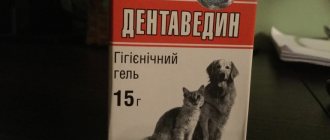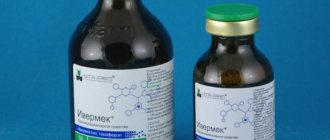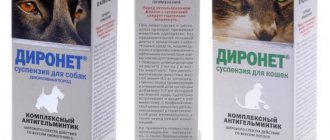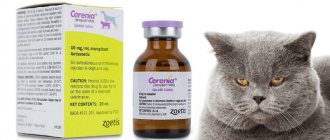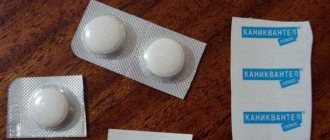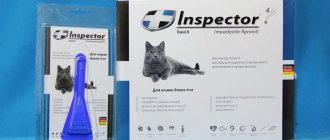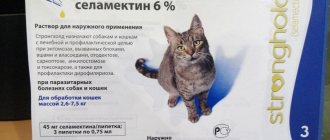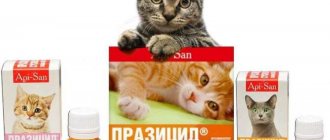Composition and action
Dexafort contains two active ingredients - dexamethasone phenylpropionate and dexamethasone sodium. This is a synthetic analogue of the hormone produced in the body by the adrenal glands. Cortisol plays one of the central roles in the body. It ensures the functioning of the nervous and endocrine systems, affects joints and muscles, and a lack of the hormone leads to the development of many diseases.
In the animal's body, cortisol stops the production of substances that cause inflammatory processes, suppresses some receptors, as a result of which the body becomes less sensitive to many irritants, which stops the development of allergic reactions. Dexamethasone has stronger medicinal properties compared to the natural hormone:
- anti-inflammatory;
- antihistamine;
- decongestant, etc.
Dexafort is characterized by its speed and prolonged effect on foci of inflammation in the pet’s body. Within an hour, the maximum concentration of the active substance - dexamethasone sodium phosphate - is reached in the blood and plasma, then the drug quickly spreads through the bloodstream to all systems and organs and begins a therapeutic effect - relieves swelling, relieves inflammatory processes. Dexamethasone phenylpropionate penetrates into blood vessels much more slowly, providing a long-lasting therapeutic effect. The effect of the drug lasts up to 4 days.
Important!
Dexafort helps with severe allergies: it is more effective than other antihistamines.
Description of the drug Dexafort
Dexafort is a hormonal veterinary drug used to treat allergic and autoimmune diseases accompanied by inflammation. The drug has been given the international nonproprietary name - dexamethasone.
Dexafort formula was developed in the Netherlands
The manufacturer of Dexafort is the Dutch organization Intervet International BV. In 2011, the company's management announced a change in the company's name to Merck Animal Health (MSD), but the Russian division operates as Intervet MSD Animal Health LLC. The company has representative offices in more than 50 countries; MSD pharmaceutical products are in demand in 140 countries.
Composition of the medicine
The active ingredients in 1 ml of Dexafort are:
- dexamethasone phenylpropionate - 2.67 mg;
- dexamethasone sodium phosphate - 1.32 mg.
As excipients:
- sodium chloride - 4.0 mg;
- sodium citrate - 11.4 mg;
- benzyl alcohol - 10.4 mg;
- methylcellulose MH50 - 0.4 mg;
- tragacanth - 1.0 mg;
- sodium hydroxide;
- hydrochloric acid until pH reaches 7.0–7.8;
- water for injections up to 1 ml.
Only active ingredients are indicated on the drug label
Release form of the drug
The release form of Dexafort is a white suspension for injection. The drug is packaged in 50 ml bottles made of colorless glass. Each bottle is sealed with a rubber stopper, which is covered with a metal cap. Each unit of the drug is packaged in a cardboard box along with instructions for use.
In the store you can find two types of packaging - in white-blue and white-green boxes. This is due to the fact that the company changed not only its name, but also its image. The product of an earlier release is sold in the old design. There is no need to be afraid of this, but when purchasing, pay attention to the expiration date.
Despite the large volume of the bottle, it is equipped with a convenient cap, which allows you to maintain the sterility of the drug for as long as possible
Storage conditions for Dexafort
The manufacturer recommends storing Dexafort under the following conditions:
- in sealed manufacturer's packaging;
- separately from food and feed;
- in places inaccessible to children;
- in a dry place, protected from direct sunlight;
- at temperatures between 15°C and 25°C.
The shelf life of Dexafort is 3 years from the date of manufacture, but an opened bottle can be stored for no more than a month . Spoiled or expired medicine should be disposed of according to general rules.
The production date and expiration date of the unopened drug are indicated on the side of the bottle label.
Purpose
Dexafort is used as a medicine for the development of inflammatory processes in the pet’s body and swelling of the joints. The hormonal drug helps eliminate the manifestations of allergic dermatitis, asthma, as well as:
- traumatic swelling;
- joint inflammation;
- local hyperemia in skin lesions, open wounds, etc.;
- acute mastitis, etc.
In addition, Dexafort can be used as a first aid remedy for laryngeal edema and anaphylactic shock.
Among inflammatory diseases in pets, joint pathologies occupy one of the first places. They limit the cat's mobility and are always accompanied by pain. Many diseases require surgical intervention, but to stop the inflammatory process and relieve pain, veterinarians recommend Dexafort.
Domestic cats are often diagnosed with arthritis, a purulent inflammatory disease that is accompanied by increased body temperature, joint pain and swelling, and lameness. Treatment includes the use of anti-inflammatory drugs. Pain is also accompanied by deforming inflammation of the joint. At the same time, the pet tries to move less, shows anxiety, or, conversely, is in a depressed state.
There can be many causes of allergies in domestic cats: from low-quality industrial economy-class food, saliva and waste products of blood-sucking parasites, plant pollen and house dust, to medications, synthetic materials that make up litter for the tray.
Based on the type of allergen, types of allergies are distinguished - food, flea dermatitis, etc. But there is one type of allergic disease that cannot be cured. Atopic dermatitis is an overactive reaction of the domestic cat’s immune system to elements of the external environment - microscopic particles of dust, pollen, chemicals, mold that are in the air and cannot be completely eliminated. Manifestations of an allergic reaction to any type of irritant are:
- itching;
- baldness;
- rash - “feline eczema”;
- formation of granulomas on the chin and near the mouth.
The use of Dexafort is justified for the following diseases:
- arthritis and arthrosis;
- intervertebral hernia;
- bursitis and other pathologies of the locomotor system;
- eczema;
- lupus erythematosus;
- pathologies of the nervous and respiratory systems;
- oncological diseases.
Indications for use
Dexafort is used to treat swelling and inflammation, eliminate allergic reactions and autoimmune diseases.
Most often, the drug is prescribed for the treatment of the following diseases:
- allergic skin lesions - dermatitis, eczema, etc.;
- bronchial asthma;
- swelling and inflammatory processes resulting from mechanical trauma, for example, from a fall from a height;
- inflammatory diseases of the joints - arthritis, arthrosis, and so on;
- acute mastitis - inflammation of the mammary glands.
Rarely, this drug is used to relieve inflammation from insect bites, such as bees, wasps and ticks. Sometimes it is also prescribed for infectious diseases as one of the components of complex therapy.
Dosage
Dexafort injections can only be given after they have been prescribed by a veterinarian. Hormonal drugs are an insidious thing. They have many contraindications, and with long-term use, dependence on dexamethasone may occur, when the usual dose of the drug ceases to have a therapeutic effect. If it is necessary to inject hormones, you have to increase the dose and give the medicine for life. It is impossible to abruptly stop taking hormonal medications.
Dexafort is administered subcutaneously or intramuscularly. It is easier to give injections in the withers area - there are no nerve endings there. You need to slightly pull the skin at the withers, pierce it and slowly inject the medicine, holding the syringe at an angle of 45 degrees.
To give an injection in the thigh, you should secure the cat so that it does not break the needle with a sudden movement. The hind leg needs to be slightly bent and the pet calmed down to relax the muscles. Then feel the one on the thigh that rolls under your fingers and inject the medicine.
A single dose of the drug is 0.25-0.5 ml. The veterinarian will calculate it based on the weight of the animal and the severity of the condition. The injection is given once, and if necessary, it is repeated after a week.
User reviews
Many veterinarians and pet owners note the high effectiveness of the drug in the fight against autoimmune and inflammatory diseases, as well as swelling and redness after injuries and bites. Among the disadvantages of the drug, there are quite frequent side effects. Many negative reviews of Dexafort for cats indicate the high price of the drug and the need to buy much more than is needed for a standard course of treatment.
My cat is 7 years old, she lives in an apartment, but often goes outside for a walk. Once she returned with a bruised paw - her hind limb was swollen in the hip area, the cat was limping, and also stopped eating, drinking and allowing herself to be petted. We went to the vet - he said that the bruise was severe, most likely from a fall from a height. The cat was treated at the site of the injury and given only one injection of Dexafort. The inflammation decreased very quickly, the pet began to walk (albeit with a limp) in the evening, and began to eat and drink again.
Andrey
I have been working with this drug for about 5 years. As a veterinarian, I can say that with frequent and long-term use, Dexafort often has unpleasant side effects that are difficult to treat - metabolism suffers the most. But one or two injections are usually well tolerated and the medicine has helped many cats and owners in this regard.
Vitaly
One day my cat started scratching himself very hard.
He scratched until he bled and wouldn’t stop, so I had to take him to the vet for an examination. We found out the reason - it turned out to be an allergy. The cat's wounds were treated and Dexafort was injected, and he was also prescribed hypoallergenic food and given a list of foods that should be excluded from the diet. The next day he stopped itching. A week later, as recommended, we injected again, but this time ourselves. The allergy did not return again Daria
Restrictions
Dexafort cannot be used uncontrolled: hormonal drugs have many contraindications, so during a visit to the veterinarian you should tell them if your pet has chronic diseases. Restrictions on the use of the drug:
- pet weight less than 1 kg (kittens);
- acute and chronic kidney pathologies;
- heart failure;
- liver dysfunction;
- injuries associated with violation of bone integrity;
- diabetes;
- ulcer and others.
The grounds for the ban are pregnancy and lactation. Dexafort suppresses the body's immune response, so hormone therapy cannot be combined with vaccination.
With a single use of the drug, side effects are rarely observed, but sometimes deviations from the pet’s normal behavior are observed: increased thirst, increased appetite, physical weakness and apathy, weight loss and other negative symptoms.
Precautionary measures
Rules that are recommended to be followed:
- Do not exceed the dose of the drug, otherwise it can cause respiratory and cardiac arrest.
- Do not use a long needle for the procedure and do not inject the suspension quickly.
- There is no need to treat the injection site with antiseptics.
- Use a new syringe each time. Do not use the same needle twice.
- Use the medication with caution in cats with liver damage. This increases the risk of adverse reactions.
- If the animal has had a heart attack or has serious heart disease, you should notify your doctor before administering the injection.
- The medication is not intended for long-term therapy and can provoke pathologies of the kidneys and adrenal glands.
- Treatment of kittens younger than two months is not recommended.
- It is recommended to wear gloves before administering the injection.
- After handling the drug, it is important to wash your hands thoroughly.
- The medicine package should be kept out of the reach of children.
Attention! If immediately after administering the suspension the animal’s condition worsens, it is important to take it to a veterinary clinic.

